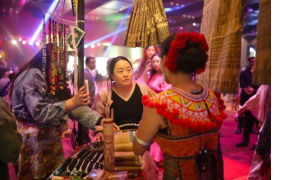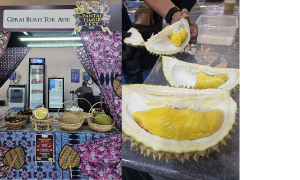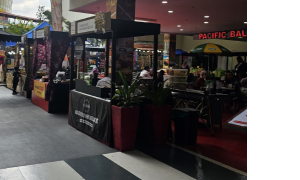
Oct 14 2025.
views 287By Rihaab Mowlana
Photo credit:
Spice Market Photos - @myceb & @mitec_my
Other Photos - Rihaab Mowlana
They handed me a paper token under a canopy of golden lights and spice-scented air. It wasn’t real currency, but it felt like a passport. A quiet invitation to step into Malaysia’s story, not just watch it unfold. The Spice Market Reception Dinner, held on Day 2 of Global Travel Meet 2025, wasn’t just a celebration. It was a full-sensory experience designed to immerse, enchant, and, most importantly, engage.
Organised by Tourism Malaysia and hosted at the Malaysia International Trade and Exhibition Centre (MITEC), the event was styled as a walk-through bazaar reminiscent of the Melaka Sultanate era. Vendors in traditional dress offered locally made products, from woven crafts to hand-blended spice sachets. Lively music pulsated through the space, performers weaved through the crowd, and the smell of excitement lingered in the air. The token I was given translated to an amount guests could "spend" at any stall. Real vendors. Real goods. Real exchange. A smart mechanism that allowed international delegates to participate in a curated, culturally rich marketplace, while giving Malaysian artisans an actual commercial platform. And yet, this wasn’t the only space where culture was offered, not as performance, but as an invitation.

In a world where tourism events often feel formulaic, this felt alive. There was no stage or speech to sit through. Instead, every step, every stall, every bite was a conversation. You could run your fingers along handwoven baskets, admire batik clothing dyed in deep, earthy tones, or chat with a jewellery maker stringing beads into traditional patterns passed down through generations. Nothing felt mass-produced or generic. Each item carried a story; something personal, textured, and unmistakably local.
And that spirit wasn’t confined to just one venue. Throughout Kuala Lumpur, pop-up stalls had been strategically placed outside key locations - near the World Trade Centre, shopping malls, and even hotel entrances. These weren’t random; they were timed and positioned to coincide with major events like the Global Travel Meet. For someone like me, whose schedule was packed with back-to-back sessions, tours, and hotel-based engagements, the chances of slipping away to hunt down a local fruit vendor were slim. I had almost accepted that durian - the one thing I was desperate to get my hands on - just wasn’t going to happen.
But that’s the beauty of how Malaysia plans its tourism touchpoints. Right between my hotel and the WTC, I found it. A small, well-stocked stall at a pop-up offering various grades of the legendary Musang King. It felt like the experience had come to me. I picked a Grade A durian (yes, overpriced and yes, I didn’t care). As I paid, a stool appeared behind me, tissues and water were set down beside me, and the vendor began slicing the fruit open with practised ease. He explained how to pour water into the inside of the husk and drink from it to cool the body after eating the “heaty” fruit. We chatted, he offered me handmade key tags from his hometown, and made sure I was comfortable from start to finish. I hadn’t gone looking for the experience; it had been designed to find me.

Our visit, supported by Tourism Malaysia and MITTA, coincided with these pop-ups, a reminder of how well local experiences are woven into the rhythm of city life.
And that’s the real genius. It’s not just about marketing slogans or high-end hospitality. It’s about presence. From strategic pop-ups in high-footfall areas - hotels, convention centres, shopping malls - to dinners that serve as cultural experiences, Malaysia builds in opportunities for organic, low-barrier connection. Culture isn’t packaged behind glass; it spills out into the everyday. And in doing so, it allows visitors to not just consume, but to feel included.
Even beyond these curated pop-ups, Malaysia has an electric street food culture. Not in hidden corners or backstreets - but boldly, proudly present. Hawker stalls line the roads with stainless steel carts and smoky grills. Tables are filled with locals and tourists alike, united by bowls of laksa, nasi lemak wrapped in banana leaves, and char kway teow sizzling on demand. The energy is democratic. Everyone eats the same food, in the same space, and the food speaks for itself.
For Sri Lanka, there’s something valuable to learn here. We often think of tourism through brochures and budgets, through massive festivals and press trips. Our tourism events are often hotel-ballroom-bound, too curated, too controlled. Malaysia’s secret? They let culture spill onto the street.

But sometimes, the most memorable moments - the ones people write about, share, and carry home - are built through smaller, intentional design. A street food stall that shows up near a conference venue. A dinner where guests don’t just watch cultural performances, but get to taste, touch, and shop. Spaces that feel spontaneous, yet are carefully thought through to promote local craft, street-level entrepreneurs, and interactivity.
As Sri Lanka rethinks its tourism strategy, we have an opportunity to do more than sell beaches and resorts. We can design for participation. Invite travellers into our stories - whether it’s through a grandmother’s pickle recipe sold in small jars at a hotel lobby pop-up or traditional dance forms performed in key locations. What matters is that it feels human, textured, and real. Imagine if, during a tourism conference in Colombo, we had curated pop-up stalls at the host location offering kottu, isso wade, and achcharu, alongside locally made crafts and performance. Imagine tokens handed to foreign delegates to buy things, not as pity purchases, but as genuine experiences. A chance to interact, ask questions, taste, feel, and connect. We wouldn’t need glitzy welcome dinners with speeches no one listens to. We’d need intention, design, and trust in our own culture.
That’s what Malaysia got right. The Spice Market was immersive not because it was expensive or elaborate, but because it was layered. Every sense was engaged. Every person felt like a participant. And most importantly, the locals weren’t performing culture. They were living it, sharing it, owning it.
Malaysia isn’t perfect. But in this, they’re ahead. They know that tourism isn’t just about footfalls or campaigns. It’s about memory. It’s about the details. And it’s about crafting invitations that say, "Come see who we are, and while you're at it, have a bite."
It’s not rocket science. It’s hospitality. And we, of all people, should know that best.
0 Comments